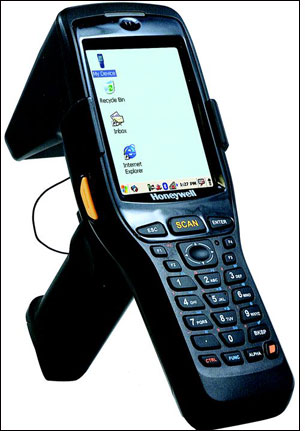Honeywell, a manufacturer of commercial and consumer technology products, has joined the ranks of RFID hardware providers, with the commercial release of its new lightweight industrial ultrahigh-frequency (UHF) RFID reader and mobile computer. The handheld Optimus 5900 reader is the first in a line of RFID hardware that Honeywell intends to develop as it ventures into the market. The new reader was released earlier this month as a smaller and lighter alternative to most handheld interrogators. The device is intended for use by companies such as apparel retailers, though it could also be utilized in warehouses, or for reading RFID tags elsewhere along the supply chain, according to Taylor Smith, the director of product marketing at Honeywell Scanning & Mobility (HSM), a manufacturer of high-performance image- and laser-based data-collection hardware, including rugged mobile computers and bar-code scanners, for retail, health-care, and transportation and logistics firms.
“Until recently, Honeywell has taken a wait-and-see approach to RFID,” Smith explains, noting that other hardware vendors have, in previous years, had mixed success marketing RFID-based products. The company has been watching the RFID industry mature, he says, especially with regard to the growth in item-level tagging for retail to improve inventory accuracy. Based on those trends, he reports, his company launched an RFID development strategy for the retailer market, by releasing the first of what may become a series of RFID products for that sector. He adds, however, that this focus “does not preclude warehouse and supply chain tracking.”
The Optimus 5900 reader is being shipped now to customers throughout North America, for use in interrogating passive UHF RFID tags complying with the EPC Gen 2 (ISO 18000-6C) standard, as well as those compliant with the ISO 18000-6B standard for passive UHF tags.The handheld, Honeywell indicates, has an ergonomic design created with retail users in mind, resulting in a device that is small, lightweight and easy to use. The reader measures 80 millimeters by 215 millimeters by 95 millimeters (3.1 inches by 8.5 inches by 3.7 inches) and weighs 21 ounces—about 60 percent of the weight of most handhelds currently on the market. The pistol grip, measuring 55 millimeters by 36 millimeters (2.2 inches by 1.4 inches), can be removed in order to enable the device to operate in a “flashlight mode” (without a handle).
The interrogator includes Microsoft Windows-based software, a 3.5-inch touchscreen display and keyboard, and a battery that provides power for up to 10 hours of continuous use on a single charge. The device features a 2-D bar-code scanner, Bluetooth and Wi-Fi connectivity, a cradle, a USB cable and a power supply for recharging its lithium-ion battery.
Although Smith declines to indicate what other RFID-based products Honeywell may release in the future, he says his company currently has no intention of releasing only the single reader. “This is Honeywell’s entry point into the market,” he states.
According to Smith, the Optimus 5900’s small form factor seems to be of the greatest appeal to potential end users. Visitors to Honeywell’s booth at a recent National Retail Federation (NRF) conference, he notes, indicated that the size was what attracted them to the mobile computer.



